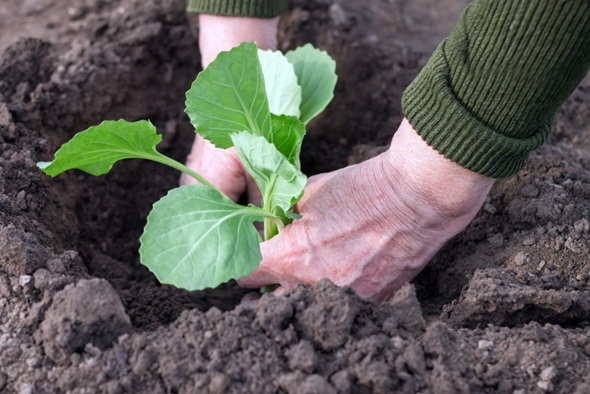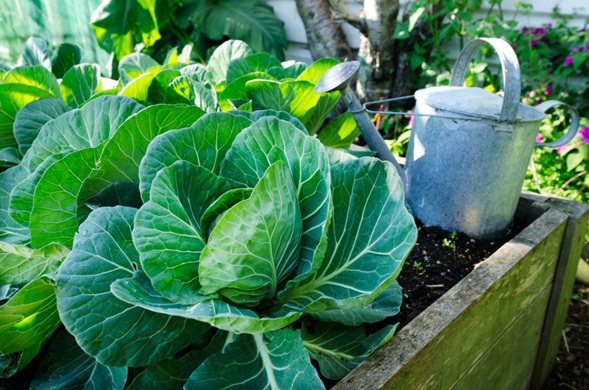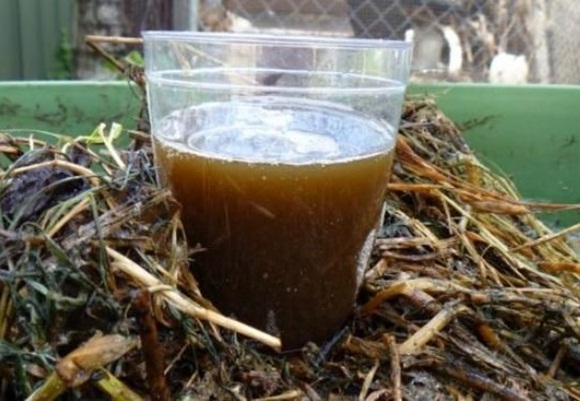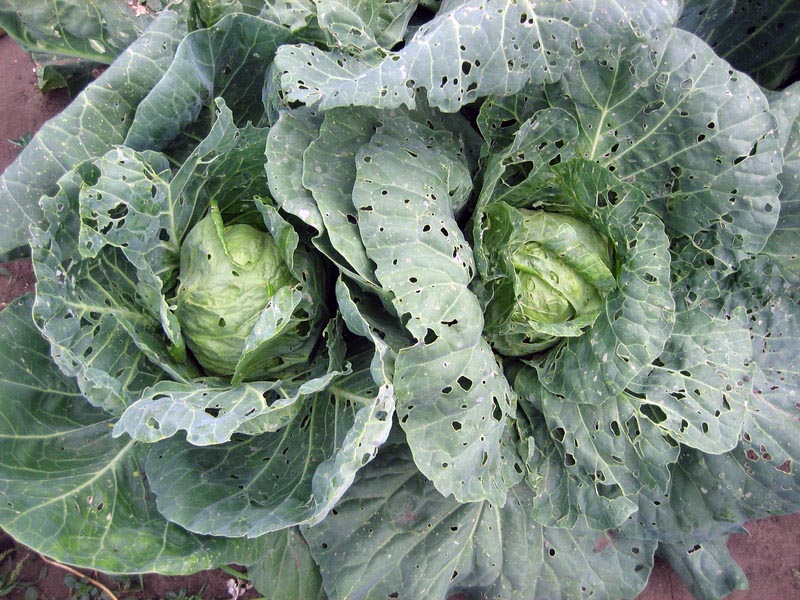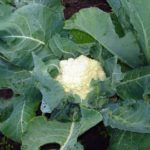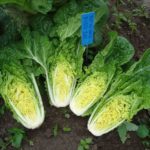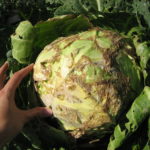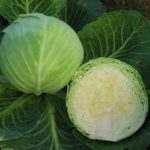Growing white cabbage is a labor-intensive process for a beginner, since there are many conditions under which the development of the plant stops and it dies without even forming a fruit inflorescence. In order to get a good cabbage harvest, it is necessary to have a spacious sunny area in the garden, not shaded by tall crops and with the required level of acidity, which is not always achievable in the country.
The main difficulty in caring for cabbage lies in the crop’s intolerance to heat, which in the middle zone in the Moscow region or Moscow region stays at 25-350 throughout the middle of summer. At this temperature, cabbage growth stops and further ripening of the ovary becomes impossible.
How to grow cabbage correctly? You can make your task easier in the absence of extensive gardening experience by purchasing modern breeding varieties of vegetables that give high yields even with some deviations in care. Reproduces white cabbage with seeds, tested for germination at home.
Planting and care in open ground, and everything else about growing a capricious vegetable - in detail below.
Preparing the soil for planting
How to get a good harvest with high density and sufficient size of inflorescences? How to grow cabbage cabbage correctly? You should start by preparing a site that should not be in a lowland, so as not to serve as a drain for rainwater, or on a hill where the sun scorches all day. Cabbage is not planted on the same perimeter for more than two years in a row. For seedlings, former potato, tomato or cucumber beds with well-loosened soil, with the remains of rotted leaves treated from insects, are ideal.
In terms of acidity level, neutral soil or one with minimal acidity levels is suitable for cabbage. These values are reduced with the help of dolomite flour or lime immediately after harvesting the previous harvest from a given area, that is, in August-October.
The airiness and oxygen saturation of poor, compressed soil is increased by the addition of sand and compost to the soil at the rate of 7-liter capacity of the mixture per 1 m2 landing area.
Fertilize the soil again in early spring, shortly after the snow melts. A large volume of mass is prepared, the formation of which occurs without maintaining strict proportions, from superphosphate and wood ash. Then, before digging, the mixture is combined with manure and the area is generously flavored. If it is not possible to get fertilizer in large quantities, you can prepare 1-2 buckets of the mixture and apply the fertilizer directly to each hole when planting.
Planting seedlings in open ground
How to grow white cabbage? Mid-season cabbage varieties can be planted in open ground at the end of April - beginning of May. Late varieties last until early June, when the earth is well warmed up. The landing time is chosen late in the evening, focusing on the weather forecast for the coming days, which promises cloudy weather or drizzling rain.
The plot of prepared soil needs to be dug up again, large clods broken up and shallow holes made, with half-meter deviations in the row and a distance of 50-60 cm between the rows. Most of the questions about why cabbage does not set can subsequently be attributed specifically to this period:
- the holes are located too often;
- the ground is not loosened well enough;
- The central bud of the sprout turns out to be immersed in the soil. This also applies to the leaves of the seedlings - they should not be buried.
Each hole, before the seedlings are in it, is filled with water, and when the plant is already planted, it is filled with dry soil to the very bottom leaves. In stable sunny weather, when it is no longer possible to delay planting, a shady awning or some kind of curtain is installed over the bed, which is removed only after 4-6 days.
You can also grow white cabbage in open ground by directly sowing the seeds into the soil.To do this, continuous grooves are made in the bed 1-1.5 cm deep, they are spilled with a weak concentration of manganese and seed material is introduced into the grooves in a thin stream. A removable greenhouse must be installed over such a garden, and caring for the seedlings at first consists only of watering.
Seeds for propagation must be checked before planting. What should be done to assess germination so that cabbage grows and develops fully and sets on time? First of all, select undamaged seeds, 5-7 times more than the amount of seedling material you need. Then the grains are tied in a cotton rag and generously moistened in a saucer.
After 5 days of constant exposure to a humid environment, healthy seeds sprout, which means they reproduce successfully. We select them for planting and grow cabbage.
Proper watering
70% of caring for white cabbage in open ground consists of proper planning of watering that corresponds to the development phases of the cabbage inflorescence. Until the seedlings have formed a full-fledged root system, watering is carried out daily, using 100-150 ml of water per hole. We must not forget about proper shading of the area so that the liquid does not evaporate too quickly.
Between the formation of a full rosette of leaves and the formation of a head of cabbage, in the flowering state of the seedlings, caring for the plant requires regular watering while maintaining soil moisture at 80%. When the heads of cabbage have set and the process of growth of the cabbage head has begun, the frequency of watering is slightly reduced, to 70%. In mid-June (12-15 days before harvest), any artificial watering stops.
It is a big mistake during the period when the cabbage is blooming and the head of cabbage is just beginning to set, to stop regular watering and organize care by rare but abundant watering of the bed on the rare days of being at the dacha. This irrational distribution of moisture is seen as the reason for the rapid growth of the root system, to the detriment of the development of the inflorescence. We must not forget that cabbage loves moisture, as long as it is freely absorbed into the soil. Cabbage does not grow long in stagnant water and soon rots.
Loosening and hilling
Agricultural technology for growing white cabbage places great emphasis on hilling plants and timely loosening of row spacing. The first loosening is carried out two weeks after planting the seedlings, further ones - as needed, so that a rough crust does not form between the plants.
The first hilling is carried out approximately at the same period or earlier. This is done to protect the thin stems of tall seedlings.
How to hill seedlings correctly? In warm weather without wind or precipitation, the soil is slightly loosened and crushed by hand at a distance of 20 cm from each individual sprout. Then, using a small rake or also with your hands, the crushed soil is collected around the stem of the seedling, forming a hill to the very bottom leaves. You can help the plant tolerate strengthening by hilling more easily by adding some gentle fertilizing two days before the procedure.
How to feed the sprouts? Experienced gardeners recommend organic fertilizers of greatly reduced concentration so that caring for cabbage does not result in burns to the roots and lower leaves of the seedling.
It is recommended to hill cabbage a second time 3 weeks after the first. The re-hilled bush strengthens in the root system and does not suffer from excess moisture.
How many procedures are required? During the development period of the vegetable, you need to hill it three times - the third time will be 45-47 days from the moment of planting, when the grown cabbage is filled with juice.
Feeding base
How to grow white cabbage without using nitrates and growth accelerators? In parallel with the first loosening and hilling, the seedlings are fed with organic fertilizer. Use chicken manure diluted with water in a concentration of 1 dry matter, 15 glasses of water. The liquid is poured into a small watering can with the diffuser removed and, carefully, lifting the leaves, the fertilizer is introduced into each hole. It is advisable to do this immediately after watering so that the solution “disperses” in the top layer of soil and does not soak into the depths.
After 14 days, the seedlings are fed with 10% mullein infusion, which was diluted and left to infuse 10 days before use. It is also used to water the sprouts when the fruits begin to set.
For supporters of mineral fertilizers, the feeding scheme for cabbage is different. On the 14th day from planting in the ground, make a solution from the following components:
- 10 g urea;
- 20 g superphosphate;
- 15 g of potassium chloride.
This dry mixture is dissolved in a bucket of water and poured into a specially dug groove exactly between the rows, which is then backfilled. 21 days after the first procedure, when the heads of cabbage have already set, a similar portion is prepared from the above elements and the whole process is reproduced exactly.
20-30 days before cutting the heads of cabbage, nitrogen fertilizers are stopped applied to the soil and watering is limited or completely stopped.
Foliar feeding is used for late seedlings if the sprouts are weak, have stopped growing or have turned yellow.The solution is prepared based on four liters of water (or half a bucket) and take for it:
- 1 kg potassium chloride;
- 70 g double superphosphate;
- 10 g molybdenum.
The composition for foliar feeding is infused for 24 hours and then used for irrigation from a household sprayer.
Cabbage diseases
What else is involved in growing and caring for white cabbage? Of course, in protecting the plant from various diseases and in urgently taking measures when they are detected. In central Russia, the most common pathological conditions of this vegetable are:
- Clubroot is a fungus that develops in the root system when there is excess moisture. Characterized by growths and swelling of individual rhizomes. There are still no remedies against clubroot, so you just need to find the diseased plant and remove it from the garden bed, and treat the soil with formaldehyde;
- White rot is expressed by a weeping white coating that occurs due to a lack of phosphorus and potassium fertilizers. To prevent the disease, it is enough to follow the feeding schedule;
- Fusarium - detected by a brown ring-shaped pattern on a cut of cabbage leaf petiole. Fusarium cannot be cured - the plant is dug up and the planting site is sprayed with furatsilin.
What to do with the lower leaves of cabbage
Whether to tear off or leave the bottom leaves of cabbage is not specified in gardening manuals, so each owner proceeds from the decision that is beneficial to him in terms of the result. For those wishing to grow a large cabbage head, the argument in favor of removing “extra” leaves is that they retain a large amount of juice, which can go directly into the head.
The list of advantages when deciding whether to pick off the leaves also includes the theory of better air exchange between plants and the fact that it is much easier to care for cabbage - loosening and hilling the rows.
Disadvantages of this task - whether to tear off large lower leaves:
- in reducing the speed of cabbage ripening. Conventionally, 1 removed leaf adds a day to the ripening period;
- in reducing the usefulness of the formed head of cabbage, since vitamin C, produced precisely in the lower leaf, does not have time to pass into the vegetable;
- in the loss of juice by the plant and the attraction of pests to this juice - aphids and cabbage moths. The latter is the scourge of cabbage in Belarus and is gradually occupying the same position in Russia.
Conclusion - it is most rational to get rid of the lower leaves when care is carried out in the last 2-3 weeks before harvesting. It is best to remove yellowed and withered leaves, but whether to tear off green and strong leaves is up to the owner to decide.

